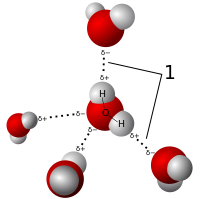
Photo from wikipedia
The change of cooperativity of FH···Cl− hydrogen bonds upon sequential addition of up to six FH molecules to the Cl− first coordination sphere is investigated. The geometry of clusters [(FH)… Click to show full abstract
The change of cooperativity of FH···Cl− hydrogen bonds upon sequential addition of up to six FH molecules to the Cl− first coordination sphere is investigated. The geometry of clusters [(FH) nCl]− (n = 1…6) was calculated (CCSD/aug‐cc‐pVDZ) and compared with [(FH) nF]− clusters. The geometry is determined by the symmetry‐driven electrostatic requirements and also by the fact that formation of each new FH···Cl− bond creates a depression in the chlorine's electron cloud on the opposite side of Cl− (σ‐hole), which limits the range of directions available for subsequent H‐bond formation. The mutual influence of FH···Cl− hydrogen bonds is anticooperative—the addition of each FH molecule weakens H‐bonds by 23–16% and decreases their covalent character (as seen by LMO‐EDA decomposition and QTAIM analysis). Anticooperativity effects could be tracked by spectroscopic parameters (frequency of local HF mode νFH, chemical shift δH, spin–spin coupling constants 1JFH, 1hJHCl, 2hJFCl and nuclear quadrupolar constants χ18F, χD, and χ35Cl. © 2019 Wiley Periodicals, Inc.
Journal Title: Journal of Computational Chemistry
Year Published: 2019
Link to full text (if available)
Share on Social Media: Sign Up to like & get
recommendations!